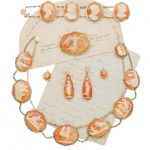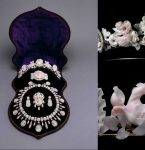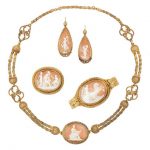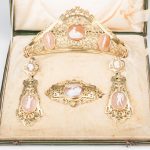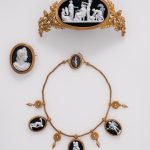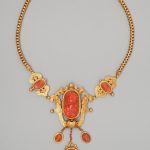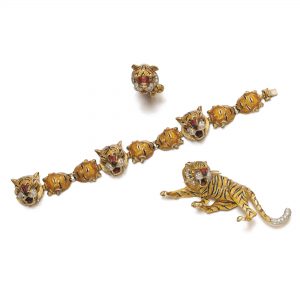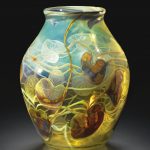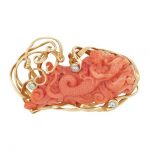Information on cameo parures. A parure is a set of jewellery which can be a combination of a matching necklace, earrings, brooch, bracelet and often a diadem or tiara. A variation is the demi-parure which consists of as few as two matching pieces, such as earrings and a necklace or brooch.
Cleverly, the parure was not static but modular and could be remade into more fashionable jewelry in order to stay au courant in the court and fashion-forward for the times. Members of court and higher social ranks vied for the best jewelers to create the most imaginative and elaborate collections that would astound one another and increase their status. Some necklaces could be worn intact or temporarily disassembled into bracelets, pendants, hair ornaments or brooches with smart interchangeable components and locking systems. Reference: Wikipedia
A shell cameo parure, circa 1830 The necklace composed of eight shell cameos each carved to depict a classical scene, including ‘The Education of Bacchus’, ‘The Birth of Minerva’, ‘Love and Psyche’ and ‘Romulus and Remus’, connected by swags of gold fancy-link chain, with a bracelet of similar design set with cameos showing profiles of classical figures, including Sappho and Venus, accompanied by a brooch, a pair of pendent earrings and a pair of links, earrings with later fittings, links with later setting, accompanied by two documents listing the scenes depicted in each cameo, lengths: necklace 41cm, bracelet 19.7cm, brooch 6.4cm, earrings 6.1cm, links 3cm, cased (illustrated on inside front cover)
Sold for £6,875 inc. premium at Bonhams in 2017
Set or parure of carved conch shell jewellery, comprising tiara (a), bracelet (b), necklace (c), brooch (d) and earrings (e-f), in the original dark red leather case (g) with blue silk lining to the lid and blue velvet for the base. Carved with marine motifs incorporating sea-horses, dolphins, mermaids and scallop shells. The larger elements are riveted to a gold wire frame, from which the smaller elements are suspended.
Technically, this is a tour de force: each piece in this set is made up of multiple elements, cut from thin sections to achieve an almost translucent effect and then riveted to a gold framework, invisible from the front. Much of the work is undercut or hollowed out with remarkable delicacy. The giant, or Queen, conch shell (Strombus gigas) was imported from the West Indies and occurs as distinct pink and white layers. Because the layers are relatively thin, and the strong colour occurs mainly on the lip of the shell, multiple pieces were often built up to create a high relief cameo effect. The parure is not marked, but there is no doubt that it was carved and mounted in Naples, the centre of the shell and coral carving industry. Shell work was widely exported to England. If not acquired on a visit to Italy, the parure may have been purchased from one of the importers of Neapolitan jewellery in London such as the Bond Street firm of Robert Phillips, who exhibited work from Naples at the London International Exhibition of 1862. The parure is included in a list of family heirlooms made by the vendor’s father in 1952 as belonging to Marie Caroline Queen of Naples ( ie. early 19th century, so this cannot be correct). See article in BM Magazine, June 2004.
Reference: © The Trustees of the British Museum
Antique Gold and Shell Cameo Parure Including a necklace, bracelet, brooch and pair of pendant-earrings, the oval shell cameos of the necklace, brooch and bracelet depicting mythological scenes, the drop-shaped shell cameo pendant-earrings depicting maenads, female followers of Dionysus, god of the vine, all framed by fluted textured gold, the necklace with double strand chased bar links, joined by stylized love knots, circa 1820, approximately 53.8 dwt. Lengths 16 3/4 and 7 3/4 inches. With original fitted box.
Overall good condition. Bracelet: cameo ap. 26.0 x 34.0 mm. Width of bracelet 1/2″. Brooch: cameo ap. 29.0 x 36.0 mm. Minor dents on reverse of frame. 1 11/16 x 1 15/16″. Earrings: wire hooks. cameos ap. 31.0 x 16.0 mm. 1 15/16 x 13/16″. Necklace: 18.0 x 22.0 mm. Good condition. Nice carvings. Top of box is broken off.
Sold for $7,500 (includes buyer’s premium) at Doyle New York in 2010
Antique French yellow gold and shell cameo parure consisting of tiara, drop earrings and brooch in original fitted case. Shell cameos depicting male and female mythological figures including two with large dogs, all mounted in pierced Greek key and scroll work settings. Gold not marked, tested electronically as 17K to 18K. No maker’s marks. Parure presented in original fitted hinged green leather gilt decorated domed box marked on base “Janisset, Passage des Panoramas No 61”. 4″ H x 5-5/8″ w x 7-3/8″ D. Passage des Panoramas was established in 1799 as one of the early glass covered indoor shopping venues in Paris. Tiara with hinged bands – 1-3/4″ H x 21″ L, Tiara itself – 1-3/4″ H x 4-3/4″ W. 30.1 grams. Drop dangle earrings: 2-5/8″ L, 15.7 grams with replaced 12K gold-filled screw-backs. Brooch – 1-1/4″ H x 2-1/4″ W, 7.9 grams. 53.7 grams total weight including replaced GF earring backs. Circa 1810. Provenance: The Estate of Charles Boyd Coleman, Jr., Chattanooga, TN. Parure accompanied by calling card of Mrs. Lewis Minor Coleman, descendant, stating “Charles Harrod’s wedding gift to his wife Hannah Rolf Dayton March 7th 1811”. Note: Hannah Rolf Dayton was the first wife of Charles Harrod, president of the Atchafalaya Bank of New Orleans and aide de camp to General Jackson at the battle of New Orleans (source: American Ancestry: Giving Name and Descent, in the Male Line, of …, Volume 6 by Thomas Patrick Hughes, _Frank Munsell – 1891 – _Albany NY ). Hannah Rolf Dayton was grand-daughter of Gen. Elias Dayton of Elizabethtown, NJ, who served under General George Washington during the Revolutionary War. They had four children including a daughter Susan Dayton Harrod Boyd, wife of William Boyd. Susan and William Boyd’s son Charles Harrod Boyd was born in 1833 and served on General George H. Thomas staff as Captain of the Topographical Engineers, Army of the Cumberland. In 1858 he married Annette Maria Dearborn, daughter of Col. Greenleaf Dearborn, U.S.A. and great granddaughter (through her mother’s side) of Major-General Henry Dearborn, commanding general of the U.S. Army during the War of 1812 and secretary of war during President Jefferson’s administration.
Earring screw-backs replaced with gold-filled fittings. Original gold mountings with minimal wear. Cameos in very good condition. Cameo to left on tiara with possible interior fracture. Case does not fully close.
Sold for $2,300 at Case Antiques, Inc. Auctions & Appraisals in 2018
Parure: tiara, necklace, and brooch Artist:Cameos carved by Luigi Saulini (Italian, 1819–1883) Designer:Designer of Diadem (a) John Gibson (British, Gwynedd, Wales 1790–1866 Rome) Date:mid-19th century
Cameo-laden parures that included tiaras became fashionable among Napoleon’s sisters and the ladies of his court. The taste survived for at least a half century. A bit of paper that accompanied the set when Weil lent it to the Metropolitan Museum in 1929 stated that the mounts were designed by John Gibson (1790–1866), a British sculptor resident in Rome, and executed by Castellani, the Roman firm of goldsmiths. Saulini’s studio was near Gibson’s, and many artists turned to Castellani for mounts in the best “archaeological” style. Certainly an able hand modeled the tiara’s acorns and oak leaves and the firm is not to be ruled out, but the leaves are pointier than in other oak jewelry known to be by Castellani.
The large stone in the tiara, despite the tradition probably not designed by Gibson, represents the toilet of Nausicaa, a rare subject even in ancient art. To ensure that Nausicaa, wise and beautiful daughter of King Alcinous of Phaeacia, would rescue the shipwrecked and travel-stained Ulysses as he slept in a bed of leaves at the mouth of the river Calliroe, Minerva directed her in a dream to go with her handmaids to the river to wash her family’s linens. Here, though, her companions lavish their attention on the princess, fixing her hair, bringing her jewelry, and reflecting her beauty in a mirror. All but one of the other cameos copy ancient marbles. The bust in the brooch is of the Vatican’s Apollo Belvedere. The three large stones in the necklace cite the statues Discobolus, Cupid and Psyche, and Cupid Stringing His Bow, the first in the Museo Nazionale in Rome, the last two in the Musei Capitolini. The unsigned nude youth with a hoop and a paddle on the clasp is after a long-lost ancient intaglio Johann Joachim Winckelmann singled out in his Thoughts on the Imitation of Greek Works in Painting and Sculpture, published in 1755. Its design survives in copies by Giovanni Pichler and others.
Reference: The Metropolitan Museum of Art
Coral and embossed gold parure Made in France, c.1840. A parure is a matching set of jewellery, usually a necklace, brooch, earrings and bracelets, and sometimes a hair or bodice ornament. First made and worn in the 1500s, parures were revived in the late 1700, and they took pride of place in the jewellery caskets of society women well into the 1800s.
This Renaissance-inspired parure includes a necklace, a large brooch, a hair ornament, a bangle and eight smaller bow brooches. It was made for wearing in the evening for formal occasions and would have suited the low-necked gowns and elaborate hair styles in fashion. It was likely that the smaller brooches were worn during the day on the sleeves and bodice of a woman’s dress. There are 30 coral cameos in this parure.
Reference: Museum of Applied Art and Science
Enamel and diamond parure, Frascarolo
Comprising: a bracelet composed of enamelled paws and tiger’s head motif links, with circular-cut ruby eyes and single-cut muzzles, length approximately 165mm; a brooch designed as a tiger, applied with enamel, set with single-cut diamonds and circular-cut ruby eyes; and a ring, size H, each with Italian assay and maker’s marks.
Sold for 10,625 GBP at Sothebys in 2018
